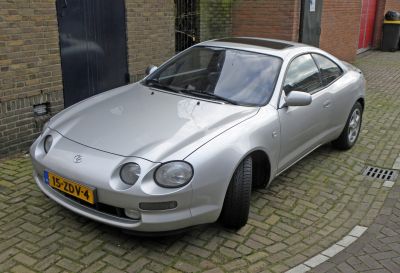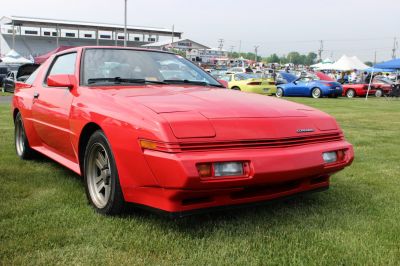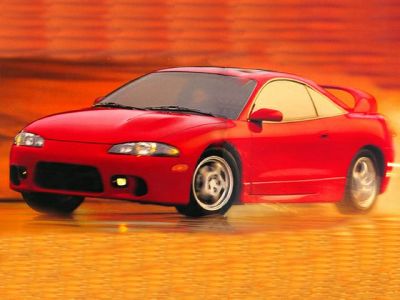 1995 Mitsubishi Eclipse II (2G) Dimensions, Size & Specs
1995 Mitsubishi Eclipse II (2G) Dimensions, Size & SpecsMeasurements of the 1995 Mitsubishi Eclipse II, engineered for optimal performance and comfort
| Dimensions | |
|---|---|
| Length: | 4375 mm172.2 in14.4 ft |
| Width: | 1735-1745 mm68.3-68.7 in5.7-5.7 ft |
| Height: | 1295 mm51.0 in4.2 ft |
| Ground Clearance: | 145 mm5.7 in0.5 ft |
| Weight Specifications | |
| Curb Weight: | 1235-1340 kg2723-2954 lbs |
| Maximal permitted Weight: | 1690-1750 kg3726-3858 lbs |
| Tire Specifications | |
| Rims Size: |
|
| Tire Size: |
|
The Mitsubishi Eclipse II (2G), produced between 1995 and 1996, marked the second generation of this popular compact sports car, available in both coupe and hatchback body styles. This generation is celebrated for its sleek design and balanced dimensions, catering to enthusiasts who value sporty performance combined with practical size. The Eclipse II measures 4375 mm (172.2 inches) in length, making it compact enough for urban driving while providing a stable road presence. Its width varies slightly between 1735 mm and 1745 mm (68.3 to 68.7 inches), depending on specific model configurations, contributing to a wider stance and improved handling dynamics. Standing at a low height of 1295 mm (51.0 inches), the car emphasizes its aerodynamic profile and sporty character.
In terms of weight, the curb weight ranges from 1235 kg to 1340 kg (2723 to 2954 lbs), reflecting variations between different trims and body types. This weight balance supports agile handling without sacrificing stability. The maximum allowable weight ranges between 1690 kg and 1750 kg (3725 to 3858 lbs), ensuring compliance with safety and performance standards.
Ride height is set at a modest 145 mm (5.7 inches), providing a low center of gravity that enhances cornering abilities. The Eclipse II rides on 15-inch rims paired with tires sized at 205/60 R15, offering a good blend of grip and ride comfort.
Overall, the Mitsubishi Eclipse II combines sporty aesthetics and performance-oriented proportions with practical dimensions. It remains a favored choice for car enthusiasts seeking a mid-90s coupe or hatchback that delivers a responsive driving experience wrapped in a compact but confident size.
Discover the standout features that make the 1995 Mitsubishi Eclipse II a leader in its class
Have a question? Please check our knowledgebase first.
The Mitsubishi Eclipse II (2G) produced from 1995 to 1996 features a length of 4375 mm (172.2 inches), which provides a balanced size typical for mid-1990s sporty coupes. The width varies slightly between 1735 mm to 1745 mm (68.3 to 68.7 inches), accommodating exterior trims and slight design changes depending on the model variant. The height is consistent at 1295 mm (51.0 inches), contributing to the vehicle's low-slung, aerodynamic profile. These dimensions combined give the Eclipse II a sleek appearance and allow for reasonable interior space while maintaining a sporty footprint on the road.
The curb weight of the Mitsubishi Eclipse II ranges between 1235 kg and 1340 kg (2723 to 2954 lbs), depending on specific trim levels and equipment. This relatively light weight for a two-door sports coupe of its time contributes positively to the vehicle’s agility and overall performance. A lighter vehicle weight helps improve acceleration, braking, and cornering response, making the Eclipse II dynamic and enjoyable to drive. The weight also impacts fuel efficiency, with the car’s moderate mass allowing for more economical consumption compared to heavier sports cars.
The Mitsubishi Eclipse II maintains a ride height or ground clearance of 145 mm (5.7 inches), which is typical for sports coupes aiming for a lower center of gravity. This clearance allows the car to hug the road well at higher speeds, enhancing stability and handling. However, the modest ground clearance means caution is needed on rough or uneven road surfaces, as the undercarriage can be susceptible to scraping on speed bumps or steep driveways. It’s optimal for urban and highway driving but less suited for rugged terrain or off-road conditions.
The Mitsubishi Eclipse II is equipped with 15-inch rims paired with tires sized 205/60 R15. These dimensions strike a balance between comfort and sportiness. A 15-inch rim size is sufficient to house a tire sidewall that absorbs road imperfections well, contributing to comfortable ride quality without sacrificing confident handling. The tire width of 205 mm provides adequate grip for spirited driving, while the 60 aspect ratio (sidewall height as a percentage of width) gives enough cushion against rough pavement and road shocks, making daily driving pleasant alongside sporty performance demands.
Yes, the Mitsubishi Eclipse II fits comfortably into a standard residential garage. With a length of 4375 mm (approximately 14.35 feet) and a width just under 1750 mm (approximately 5.75 feet), it is well within the typical dimensions of most residential garages, which usually have minimum internal dimensions of about 6 meters (19.7 feet) in length and 2.4 meters (7.9 feet) in width. Its height of 1295 mm (51 inches) is also modest, ensuring ample clearance for the garage door and any light fixtures. Therefore, owners need not worry about space constraints when parking the Eclipse II indoors.
The slight variation in width between 1735 mm and 1745 mm (68.3 to 68.7 inches) for the Mitsubishi Eclipse II likely results from differences in trim levels, optional mirrors, or minor body styling tweaks such as fender flares or side body moldings. Performance impact from this small variance is minimal, but from a design perspective, it can influence the car’s stance and aesthetic appeal. A marginally wider body can contribute to better stability through a wider track and offer a more aggressive appearance, while a narrower width may facilitate easier maneuvering and parking in tight urban spaces.
Compared to its predecessor, the Mitsubishi Eclipse I (1G), the Eclipse II (2G) introduced for model years 1995-1996 is slightly larger and more modernized. The length sits at 4375 mm compared to around 4400 mm in later 1G iterations, making the 2G similar or marginally shorter but more refined in design. The 2G also features updated styling, improved aerodynamics, and upgrades in suspension and chassis rigidity for better driving dynamics. In width and height, the 2G maintains a low and sporty profile close to its predecessor but with subtle refinements that enhance interior space and comfort. Overall, the 2G offers a fresh take with improved handling, comfort, and contemporary aesthetics compared to the 1G.
When compared to other mid-1990s compact sports coupes such as the Honda Prelude, Toyota Celica, and Mazda MX-6, the Mitsubishi Eclipse II holds its ground in terms of size and weight. Its length of 4375 mm and curb weight around 1235-1340 kg position it within the typical range for sporty coupes of that era. Some rivals like the Toyota Celica were similar in length but slightly lighter, while the Honda Prelude sometimes leaned heavier depending on trims. The Eclipse II’s balance of size and weight makes it competitive for lively driving dynamics while still providing practical dimensions for everyday usability. Its dimensions also mean it comfortably fits in the compact sports coupe segment, offering sporty styling without excessive bulk.
The maximum weight (gross vehicle weight rating) of the Mitsubishi Eclipse II ranges between 1690 kg and 1750 kg (approximately 3725 to 3858 pounds). This maximum allowable weight includes the curb weight plus the combined weight of passengers, cargo, and any additional equipment. Given its curb weight of 1235-1340 kg, this means the vehicle can safely carry an additional 350 to 515 kg (770 to 1135 pounds) before reaching its maximum rating. This capacity is adequate for typical usage of a sporty two-door coupe, comfortably accommodating up to four occupants and luggage for daily commuting or weekend trips. Exceeding this weight can detrimentally affect handling, braking, and safety.
The Mitsubishi Eclipse II (2G) was offered in two primary body styles: coupe and hatchback. The coupe version features a traditional two-door sports car design with a fixed rear window and trunk, emphasizing sporty looks and reduced weight. This style suits buyers focused on aesthetics and performance but offers limited cargo access. The hatchback variant provides a rear hatch door that opens upwards, allowing easier access to the cargo area and more flexible storage solutions—a practical feature for users who need greater versatility. The hatchback’s design offers a balance of sportiness with usability, making it appealing for those who want the car's style without compromising practicality.
Discover similar sized cars.

| Production: | 1993-1999 |
|---|---|
| Model Year: | 1994 |
| Length: | 4425 mm174.2 in |
| Width: | 1750 mm68.9 in |
| Height: | 1305 mm51.4 in |

| Production: | 1986-1989 |
|---|---|
| Model Year: | 1983 |
| Length: | 4399 mm173.2 in |
| Width: | 1735 mm68.3 in |
| Height: | 1275 mm50.2 in |

| Production: | 1997-1999 |
|---|---|
| Model Year: | 1997 |
| Length: | 4385 mm172.6 in |
| Width: | 1745 mm68.7 in |
| Height: | 1295 mm51.0 in |

| Production: | 1997-1999 |
|---|---|
| Model Year: | 1997 |
| Length: | 4385 mm172.6 in |
| Width: | 1745 mm68.7 in |
| Height: | 1295 mm51.0 in |
